NavSource Online: Aircraft Carrier Photo Archive
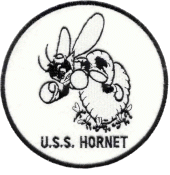
Courtesy of CAPT Gene Oleson, CHC, USN (Ret)
USS HORNET (CV-8)
Flag Hoist/Radio Call Sign: November - Easy - Tare - Cast

 |
||




|
Task Force 16 Citation
Enterprise, Hornet, 16 other ships and their 10,000 sailors,
airmen and Marines, who took part in the Doolittle raid in April 1942, were officially recognized for
their daring exploit 53 years later, on 15 May 1995. In a ceremony at the Pentagon they were presented
the Task Force 16 Citation by the Secretary of the Navy, Mr. John H. Dalton.
| Yorktown (modified) Class Aircraft Carrier | |||||
| Ordered | Laid down | Launched | Commissioned | Decommissioned | Stricken |
|---|---|---|---|---|---|
| 30 Mar 1939 | 25 Sep 1939 | 14 Dec 1940 | 20 Oct 1941 | 13 Jan 1943 | |
| Builder: Newport News Shipbuilding & Drydock Co., Newport News, Va. | |||||
 |
Fate: Hit and immobilized by Japanese carrier aircraft bombs and torpedoes, 26 October 1942 (Battle of the Santa Cruz islands). Two planes made suicide runs: one glanced off the stack and plunged through the flight deck; the second crashed into the port forward gun gallery. Cruiser USS Northampton (CA-26) made three attempts to take the carrier in tow, but the towing line failed and additional Japanese attacks frustrated these efforts. Hornet was hit again and had to be abandoned. Destroyers USS Mustin (DD-413) and USS Anderson (DD-411) tried to scuttle her with torpedoes and 5" gunfire, but had to retire as enemy forces closed in. Hornet was finally scuttled by Japanese destroyers Makigumo and Akigumo with four 24" torpedoes, early on 27 October. In all, she took two planes, 7-8 bombs, 16 torpedoes and an unknown number of 5" shells. One hundred and eleven of her crew were lost with the ship and remain on active duty. The wreckage of Hornet was found in January 2019 at the bottom of the South Pacific Ocean, around the Solomon Islands, some 17,500 feet (5,334 meters) below the surface, by the late Paul G. Allen's R/V Petrel. (Read "Final Resting Place of USS Hornet CV-8 Located in South Pacific," at the US Navy website.) |
| Displacement: | 19,900 tons standard; 25,600 tons full load |
| Dimensions (wl): | 770' x 83' 3" x 28' (full load) / 234.7 x 25.4 x 8.5 (full load) meters |
| Dimensions (max.): | 824' 9" x 109' 6¼" / 251.4 x 33.4 meters |
| Armor: | 4"-2.5" belt; 60 lbs protective deck(s); 4" bulkheads; 4" (side)-2" (top) conning tower; 4" (side) over steering gear |
| Power plant: | 9 boilers (400 psi); steam turbines; 4 shafts; 120,000 shp |
| Speed: | 32.5 knots |
| Endurance (design): | 12,500 nautical miles @ 15 knots |
| Armament: | 8 single 5"/38 gun mounts; 4 quad 1.1"/75 machine gun mounts; 24 .50-cal machine guns |
| Aircraft: | 90+ |
| Aviation facilities: | 3 elevators (48' x 44' [14.6 x 13.4 m]), 17,000 pounds [7,711.1 kg]; 2 flight-deck and 1 hangar-deck hydraulic catapults flight deck: 814' x 86' [248.1 x 26.2 m] |
| Crew: | 2,919 (ship's company + air wing) (wartime figure) |
| Click on Thumbnail for Full Size Image |
Size | Image Description | Source | |||||||||||||||
|---|---|---|---|---|---|---|---|---|---|---|---|---|---|---|---|---|---|---|
| Name |
||||||||||||||||||
 NS020869a |
145k | CV-8 was named to commemorate six American warships that had previously borne the name. A hornet is a large, strong wasp whose sting is severe (NS020869a). Hornets are the largest of the eusocial wasps, and are similar in appearance to their close relatives yellowjackets (wasps native to North America—e.g., baldfaced hornets—are commonly refered to as hornets but are actually yellowjackets). Hornets aggresively guard their nesting sites when threatened and their stings are more painful and dangerous to humans than typical wasp stings, as their venom contains a large amount of acetylcholine; moreover, individual hornets can sting repeteadly. Previous Hornets:
NS020869a: European hornet. Photo by PiccoloNamek, via Wikipedia. NS098628301: The first Hornet. Naval History & Heritage Command (NH 53412) via Robert Hurst. 020869: "A nest of Hornets." "Hornets have been buzzing around our enemies' ears ever since 1775." USN, All Hands magazine, February 1958 issue (pages 18–20). |
NavSource | |||||||||||||||
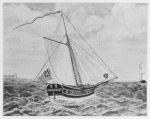 NS098628301 |
164k | |||||||||||||||||
 NS020869 |
1.19M | |||||||||||||||||
| Pre-War |
||||||||||||||||||
 NS020881 |
580k | Hornet (CV-8), keel laying at Newport News Shipbuilding, Newport News, Virginia, 25 September 1939. National Archives and Records Administration (NARA) photo, # 19-LC-26333. |
NARA | |||||||||||||||
 NS020883 |
1.08M | The future USS Hornet (CV-8), looking forward, while being constructed at Newport News Shipbuilding, Newport News, Virginia, 4 December 1939. National Archives and Records Administration (NARA) photo, # 19-LC-26338. |
NARA | |||||||||||||||
 NS020840 |
260k | Hornet under construction, Wednesday, 3 January 1940. NS020840: Looking forward. NS020840a: Looking aft. |
Gerd Matthes, Germany | |||||||||||||||
 NS020840a |
293k | |||||||||||||||||
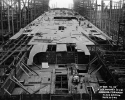 NS020882 |
697k | The future USS Hornet (CV-8) under construction, looking forward, at Newport News Shipbuilding, Newport News, Virginia, 1 August 1940. National Archives and Records Administration (NARA) photo, # 19-LC-26335. |
NARA | |||||||||||||||
 NS020841 |
93k | Hornet (CV-8) under construction, looking quarter stern, Newport News & Dry Dock Co., 3 March 1941. |
Gerd Matthes, Germany | |||||||||||||||
 NS020843 |
122k | Hornet (CV-8) under construction, 36" searchlight platform looking aft, Newport News & Dry Dock Co., 4 August 1941. |
Gerd Matthes, Germany | |||||||||||||||
 NS020865 |
176k | Hornet (CV-8) is shown in Dry Dock at Newport News in 1941. |
Ron Reeves | |||||||||||||||
 NS020878 |
205k | Bow of the soon-to-be USS Hornet (CV-8), Hampton Roads, VA. The bow of the Moore-McCormack Lines Mormacland, being converted into an aircraft carrier, can be seen in the left background. From LIFE magazine, 1 September 1941. |
David Upton | |||||||||||||||
 NS020867 |
390k | These are photographs of Aircraft Carrier Number 8, Hornet, at Newport News Shipbuilding in late 1941. At the time these photographs were taken, the shipyard's 17,500-man force was working on several other ships, including the battleship Indiana (BB-58), the aircraft carrier Essex (CV-9), and the light cruisers Birmingham (CL-62) and Mobile (CL-63). |
Courtesy of the Hampton Roads Naval Museum David Buell Bob Canchola |
|||||||||||||||
 NS020867a |
281k | David Buell | ||||||||||||||||
 NS020844 |
214k | "The U.S.S. Hornet, Navy's newest aircraft carrier which was commissioned last October [1941]. She is the last word in seagoing airports." Photo dates from 13 October 1941, while fitting out at Newport News Shipbuilding & Dry Dock Co. |
Dan Wilmes, for his father Robert Wilmes, USS Dawn (IX-186) | |||||||||||||||
 NS020857 |
118k | "Newest Carrier Commissioned" "Norfolk, Va.—The Navy's seventh and newest aircraft carrier, the Hornet, as she put into Norfolk Navy Yard for commissioning ceremonies after short trip from Newport News, Va., yards where she was built." Acme Photo, 20 October 1941. |
Tommy Trampp | |||||||||||||||
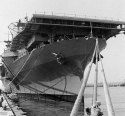 NS020857c |
317k | Starboard bow view of USS Hornet (CV-8), 20 October 1941, at Norfolk Navy Base, the day of her commissioning. Life Magazine Archives, Thomas McAvoy photographer, shared by Peter DeForest. |
Mike Green John Chiquoine |
|||||||||||||||
|
||||||||||||||||||
 NS020804 |
140k | USS Hornet just after commissioning, 20 October 1941. She was painted in Measure 12 camouflage. Armament and radar had yet to be fitted. Mk.37 directors on the island differentiated her from her older sisters Yorktown and Enterprise, fitted with Mk.33 directors. (Thanks to Robert Hurst, who provided additional info). Note that Hornet's hull number was actually CV-8. |
John Spivey | |||||||||||||||
 NS020801 |
336k | As completed, 27 October 1941. National Archives photo # 80-G-463613. |
National Archives | |||||||||||||||
 NS020842 |
205k | USS Hornet (CV-8) in dry dock at the Norfolk Navy Yard, 19 November 1941, being inspected for any defects on her hull during her shakedown, a month after being commissioned into the U.S. Navy. |
Gerd Matthes, Germany | |||||||||||||||
 NS020842a |
113k | November 1941. See above. |
Gerd Matthes, Germany | |||||||||||||||
 NS020803 |
99k | USS Hornet (CV-8) photographed circa late 1941, soon after completion, probably at a U.S. east coast port. Note flight deck overhang and large crane stowed in the small boat area. A ferry boat and "Eagle Boat" (PE) are in the background. U.S. Naval Historical Center Photograph (# NH 81313). |
NHC | |||||||||||||||
NS020835 |
104k | Line drawing ©Jean Secardin. |
©Jean Secardin | |||||||||||||||
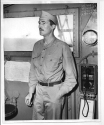 NS020805 |
389k | Commander Stanhope Cotton Ring (USNA 1923) served as Commander, Hornet Air Group, from August 1941 through July 1942. |
Bill Gonyo | |||||||||||||||
 NS020886 |
122k | "Squadron commanding officer's F4F-3 Wildcat from the aircraft carrier Hornet before that ship was withdrawn by Admiral Ernest J. King from the Atlantic to the Pacific to carry out the famous Tokyo Raid. With a top speed of 330 mph, the Wildcat was slower and less maneuverable than the Zero, her main opponent. Only by devising tactics that optimized the Wildcat's advantages, heavy firepower and rugged construction, could F4F fighter pilots effectively combat the Japanese." Photo and text from The Naval Air War, 1939–1945, by Nathan Miller, p.81. |
Tommy Trampp | |||||||||||||||
| World War II |
||||||||||||||||||
 NS020831c |
160k | USS Hornet (CV-8), closeup view, starboard side in way of island, showing new 20mm battery, Mk-4 (FD) radar on forward Mk-37 director, new rig for fueling at sea, hose, etc. Norfolk Navy Yard, Portsmouth, Va., Saturday, 28 February 1942. Photo serial #2788[?](42). |
Pieter Bakels | |||||||||||||||
 NS020831a |
45k | USS Hornet (CV-8), closeup view, starboard side in way of island, showing altered searchlight platform access ladders, docking bridge, life raft stowages, new 20mm battery, forward boat crane removed, etc. Norfolk Navy Yard, Portsmouth, Va., Saturday, 28 February 1942. Photo serial #2789[?](42). |
||||||||||||||||
 NS020831b |
52k | USS Hornet (CV-8), view from island looking forward, showing forward 1.1", 20mm and 5" guns, starboard side; no. 1 1.1" director, racks for 1.1" magazines inside splinter bulwarks, etc. Norfolk Navy Yard, Portsmouth, Va., Saturday, 28 February 1942. Photo serial #2790(42). |
||||||||||||||||
 NS020831 |
137k | USS Hornet, closeup view, after end and port side of island showing No. 3 director and foundation, altered flag bridge and primary fly control and 36" searchlight platforms, FD radar installed on 5" directors, etc. Norfolk Navy Yard, Portsmouth, Va., Saturday, 28 February 1942. Photo serial #2791[?](42). |
Steve Whitby Larger copy submitted by Pieter Bakels |
|||||||||||||||
 NS020831d |
108k | USS Hornet (CV-8), forward end of island showing splinter protection for gunnery control station and sky lookout platform, SC radar antenna installed, port pelorus relocated to top of fly control. Norfolk Navy Yard, Portsmouth, Va., Saturday, 28 February 1942. Photo serial #2792(42). |
Pieter Bakels | |||||||||||||||
 NS020831e |
175k | At Norfolk Navy Yard, Portsmouth, Va., Saturday, 28 February 1942. While at Norfolk she was camouflaged to Measure 12 with splotches; colors were Navy Blue, Ocean Gray and Haze Gray. By this time Mk.4 radar had been added to the Mk.37 directors. (Thanks to Robert Hurst and Michael Vorrasi, who provided additional info). |
Original photos submitted by Steve Whitby. Larger photos submitted by Michael Vorrasi. |
|||||||||||||||
 NS020831f |
142k | |||||||||||||||||
 NS020831g |
134k | Michael Vorrasi | ||||||||||||||||
 NS020831h |
201k | Same as above. The planes parked on the forward end of the flight
deck (visible in the foreground) are Grumman F4F-4 Wildcats of VF-8 and Curtiss SBC-4s from
either VB-8 or VS-8. Note the rat guards on the mooring lines.
U.S. Navy Photograph now in the collections of the National Archives and Records Administration, Still Pictures Division, College Park, Md. Photo # 19-N-28429. |
Mike Green | |||||||||||||||
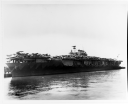 NS020831i |
301k | USS Hornet (CV-8), photo taken while alongside Pier 7, Naval Operating Base,
Norfolk, Virginia, in February 1942, prior to her departure for the war zones. Her air group consists
of Grumman F4F-4 Wildcats of Fighting Squadron (VF) 8, Curtiss SBC-4 Helldivers of Scouting
Squadron (VS) 8 and Bombing Squadron (VB) 8, and Douglas TBD-1 Devastators of Torpedo Squadron
(VT) 8. Camouflage on ship is measure 12 (Mod.).
U.S. Navy Photograph now in the collections of the National Archives and Records Administration, # 19-N-28431. |
||||||||||||||||
 NS020860 |
126k | View of the flight deck and island of USS Hornet (CV-8), taken pre-Midway, in early 1942 as this is a screen capture and the film scenes show the planes to still have red centers on the star insignia as well as red & white tail stripes. |
Michael Vorrasi | |||||||||||||||
| Doolittle Raid on Japan, April 1942 |
||||||||||||||||||
NS020802 |
18k | April 1942, as she appeared in the Pacific. | USN | |||||||||||||||
 NS020875 |
63k | Approaching the Gate to Destiny, USS Hornet (CV-8), her deck crowded with B-25B Mitchells, departs San Francisco for Doolittle Raid. Artwork by William S. Phillips. |
Tom Gonzalez Tommy Trampp |
|||||||||||||||
 NS020875a |
96k | Toward the Setting Sun, artwork by William S. Phillips. As VS-6 SBDs patrol the skies above, USS Hornet (CV-8)—with the Doolittle Raiders' sixteen B-25 Mitchells lashed down across her deck—steams majestically toward her Japanese target. |
Ron Jensen & Ron Reeves | |||||||||||||||
 NS020838 |
85k | Navy blimp L-8 approaches USS Hornet (CV-8) to deliver parts for the mission's B-25B aircraft. Taken shortly after the ship left San Francisco to begin the operation, circa 4 April 1942. Note package hanging below the airship. Naval History & Heritage Command photo (# NH 53288). |
Gerd Matthes, Germany | |||||||||||||||
 NS020838a |
64k | Navy blimp L-8 hovers over USS Hornet (CV-8) while delivering parts for the mission's U.S. Army Air Force aircraft. Taken shortly after the ship left San Francisco to begin the operation, circa 4 April 1942. Note USAAF B-25B bomber parked on the flight deck. Naval History & Heritage Command photo (# NH 53294). |
Gerd Matthes, Germany | |||||||||||||||
 NS0543305 |
334k | View looking aft from the island of USS Hornet (CV-8), while en route to the mission's launching point. USS Gwin (DD-433) is coming alongside, as USS Nashville (CL-43) steams in the distance. Eight of the mission's sixteen B-25B bombers are parked within view, as are two of the ship's SBD scout bombers. Note midships elevator, torpedo elevator, arresting gear and flight deck barriers in the lower portion of the photo, and 1.1" quad anti-aircraft machine gun mount at left. Naval History & Heritage Command photo (# NH 53289). |
Fred Weiss Bob Canchola, BT, USN (Ret.) |
|||||||||||||||
 NS020872 |
276k | Colorized version of the photo above. |
Courtesy of Alex Colors Studio, via Yu Chu |
|||||||||||||||
 NS020839 |
133k | Two of the operation's sixteen USAAF B-25B bombers, parked on the flight deck of USS Hornet (CV-8), while en route to the mission launching point. The plane at right has tail # 40-2282. It is mission plane # 4, piloted by Lieutenant Everett W. Holstrom, Jr. during the raid, in which it attacked targets in Tokyo. Note protective cover over its gun turret, and wooden dummy guns mounted in its tail cone. The plane at left is warming up its engines, as was done periodically during the voyage. Naval History & Heritage Command photo (# NH 53290). |
Gerd Matthes, Germany | |||||||||||||||
 NS0543307 |
124k | Crewmen work on a USAAF B-25B parked at the rear of USS Hornet's (CV-8) flight deck, while en route to the mission's launching point. USS Gwin (DD-433) is in the center, approaching the carrier from astern. Naval History & Heritage Command photo (# NH 53291). This B-25B Mitchell (40-2268) "Bat Out of Hell", 89th Reconnaissance Squadron, piloted by Lieutenant Bill Farrow (at right) was the last plane off the deck of Hornet. (Source: Two Flights To Victory: From The Doolittle Raid To The Enola Gay, by David G. Styles, via Robert Hurst.) |
Fred Weiss | |||||||||||||||
 NS0543304 |
83k | USS Gwin (DD-433) approaches USS Hornet (CV-8) from astern, with USS Nashville (CL-43) beyond, while en route to the mission's launching point. The ships are framed by the tail of a USAAF B-25B, parked on the rear of the carrier's flight deck. Naval History & Heritage Command photo (# NH 53292). |
Fred Weiss | |||||||||||||||
 NS020839a |
106k | View looking aft and to port from the island of USS Hornet (CV-8), while en route to the mission's launching point. USS Vincennes (CA-44) is in the distance. Several of the mission's sixteen B-25B bombers are visible. That in the foreground is tail # 40-2261, which was mission plane # 7, piloted by Lieutenant Ted W. Lawson. The next plane is tail # 40-2242, mission plane # 8, piloted by Captain Edward J. York. Both aircraft attacked targets in the Tokyo area. Lt. Lawson later wrote the book Thirty Seconds over Tokyo. Note searchlight at left. Naval History & Heritage Command photo (# NH 53293). |
Gerd Matthes, Germany | |||||||||||||||
 NS020839b |
95k | Some of the mission's B-25B bombers parked on the flight deck of USS Hornet (CV-8), while en route to the raid's takeoff point. Note use of the flight deck tie-down strips to secure the aircraft. Naval History & Heritage Command photo (# NH 53295). |
Gerd Matthes, Germany | |||||||||||||||
 NS020839c |
136k | Army Air Forces B-25B bombers parked on the flight deck of USS Hornet (CV-8), while en route to the mission's launching point. The plane in the upper right is tail # 40-2242, mission plane # 8, piloted by Captain Edward J. York. Note use of the flight deck tie-down strips to secure the aircraft. Location is near the forward edge of the midships aircraft elevator. Naval History & Heritage Command photo (# NH 53296). |
Gerd Matthes, Germany | |||||||||||||||
 NS020810 |
122k | Lieutenant Colonel James H. Doolittle, USAAF (left front), leader of the raiding force, talks with Captain Marc A. Mitscher, USN, Commanding Officer of USS Hornet (CV-8), on board Hornet sometime before the 18 April 1942 launch of the raiding airplanes. Members of the Army Air Forces flight crews, and the wing of one of their B-25B bombers, are in the background. Official U.S. Navy Photograph, now in the collections of the U.S. National Archives (photo # 80-G-41190). |
Scott Dyben | |||||||||||||||
 NS020810c |
125k | Lieutenant Colonel James H. Doolittle (left front), leader of the attacking force, and Captain Marc A. Mitscher, Commanding Officer of USS Hornet (CV-8), pose with a 500-pound bomb and USAAF aircrew members during ceremonies on Hornet's flight deck, while the raid task force was en route to the launching point. Naval Historical & Heritage Command photo (# NH 64472). |
NH&HC | |||||||||||||||
 NS020810d |
306k | "In an unusual ceremony on the eve of the raid, Mitchell crews look on as Hornet skipper Captain Marc Mitscher hands Doolittle medals that Japanese dignitaries had presented to visiting U.S. sailors. The lieutenant colonel then attached them to the 500-pound bomb for return delivery to Japan. (National Archives)" |
Tommy Trampp | |||||||||||||||
 NS020810a |
267k | Lieutenant Colonel James H. Doolittle, USAAF (front), leader of the raiding force, wires a Japanese medal to a 500-pound bomb, during ceremonies on the flight deck of USS Hornet (CV-8), shortly before his force of sixteen B-25B bombers took off for Japan. The planes were launched on 18 April 1942. The wartime censor has obscurred unit patches of the Air Force flight crew members in the background. Official U.S. Navy Photograph, now in the collections of the National Archives (photo # 80-G-41191). |
Gerd Matthes, Germany | |||||||||||||||
 NS020810b |
70k | Lieutenant Colonel James H. Doolittle, USAAF, wires a Japanese medal to a bomb, for "return" to its originators in the first U.S. air raid on the Japanese Home Islands, April 1942. Photographed on board USS Hornet (CV-8), shortly before LtCol. Doolittle's B-25 bombers were launched to attack Japan. Naval Historical & Heritage Command photo (# NH 102457). |
Tom Kermen | |||||||||||||||
 NS020824 |
113k | North American B-25B's tied down to Hornet's deck, April 15th, 1942. Aircraft # 02298 was the 6th B-25 to take off and was flown by Lt. Dean E. Hallmark. All 16 of these aircraft were built in Inglewood, California. | Steve Whitby | |||||||||||||||
 NS020825 |
111k | Doolittle's own aircraft (Sr. No. 02344) lashed to Hornet's deck, April 16th, 1942. | Steve Whitby | |||||||||||||||
 NS020833 |
62k | View looking aft from the island of USS Hornet (CV-8), while en route to the mission's launching point. USS Nashville (CL-43) is in the distance. Photo taken off a 16mm film. |
Image courtesy of Periscope Film | |||||||||||||||
 NS020833a |
125k | View looking aft from the island of USS Hornet (CV-8), while en route to the mission's launching point. USS Nashville (CL-43) is in the distance. Eight of the mission's sixteen B-25B bombers are visible on the carrier's flight deck. Aircraft at right is tail # 40-2250, which was mission plane # 10, piloted by Lieutenant Richard O. Joyce, which attacked targets in the Tokyo area. Naval History & Heritage Command photo (#NH 53421). |
Gerd Matthes, Germany | |||||||||||||||
 NS020833b |
90k | USAAF B-25B bombers and Navy F4F-3 fighters on the flight deck of USS Hornet (CV-8), while she was en route to the mission's launching point. Note wooden dummy machine guns in the tail cone of the B-25 at left. Naval History & Heritage Command photo (#NH 53422). |
Gerd Matthes, Germany | |||||||||||||||
 NS020833f |
121k | U.S. Navy Douglas SBD-3 Dauntless dive bombers of Bombing Squadron (VB) 8 and Scouting Squadron (VS) 8 tied down on the flight deck of USS Hornet (CV‑8) during the carrier's participation in launching the "Doolittle Raiders" against Tokyo, April 1942. Note that parts of the wings and tails of some of the USAAF North American B-25B Mitchell bombers are visible in the photograph. National Naval Aviation Museum photo (# 1996.253.651). |
Robert Hurst | |||||||||||||||
 NS020833c |
105k | USAAF B-25B bombers tied down on the flight deck of USS Hornet (CV-8), while the carrier was en route to the mission's launching point. The plane in the center (second from the camera) is tail # 40-2283. It was mission plane # 5, piloted by Captain David M. Jones, which attacked targets in the Tokyo area. Naval History & Heritage Command photo (#NH 53425). |
Gerd Matthes, Germany | |||||||||||||||
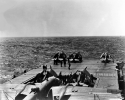 NS020833e1 |
577k | Most of Hornet's Air Group (made up of 30 F4F-4 Wildcats from VF-8, 12 SBD-3 Dauntlesses from VB-8, 12 SBD-3's from VS-8, and 10 TBD-1 Devastators from VT-8) was carried down in the hangar, but five Wildcats were kept up on deck in case they were needed in an emergency. |
Bob Canchola, BT, USN (Ret.) | |||||||||||||||
 NS020833e |
175k | Gerd Matthes, Germany Bob Canchola, BT, USN (Ret.) |
||||||||||||||||
 NS020833d |
102k | USAAF B-25B bombers tied down on the flight deck of USS Hornet (CV-8), while the carrier was en route to the mission's launching point. View looks aft from the rear of Hornet's island. The plane in the foreground is tail # 40-2303 (mission plane # 9). Partially visible at far right is tail # 40-2250 (mission plane # 10). Piloted respectively by Lieutenants Harold F. Watson and Richard O. Joyce, these B-25s attacked targets in the Tokyo area. Naval History & Heritage Command photo (#NH 53426). |
Gerd Matthes, Germany | |||||||||||||||
 NS020834 |
30k | Nose art on B-25B "Hari Kari-er" (USAAF serial # 40-2249), photographed while the plane was parked aboard USS Hornet (CV-8), en route to the raid launching point. This aircraft was mission plane # 11, piloted by Captain Charles Ross Greening. It attacked targets in the Yokohama area. Photo taken off a 16mm film. |
Image courtesy of Periscope Film | |||||||||||||||
 NS020834a |
89k | Nose of one of the raiding force's B-25B bombers, which is tied down on the flight deck of USS Hornet (CV-8) while en route to the takeoff point. This aircraft is mission plane # 11 (USAAF serial # 40-2249), nicknamed "Hari Carrier" and decorated accordingly. The plane's pilot was Capt. C. Ross Greening. It attacked targets in Yokohama. Note slippage mark on the nosewheel and tire, and inscription on the wheel cover: "Inflating instructions inside — check tire pressure daily". U.S. Naval History & Heritage Command photograph (# NH 53287). |
Gerd Matthes, Germany | |||||||||||||||
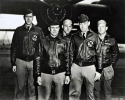 NS020884 |
603k | Plane #1. Serial #40-2344. Take off at 0820 Ship Time. Left to right: 2nd Lt. Henry A. "Hank" Potter, navigator; Lt. Col. James "Jimmy" Harold Doolittle, pilot; SSgt. Fred Anthony Braemer, bombardier; 2nd Lt. Richard E. Cole, co-pilot; SSgt. Paul John Leonard, engineer/gunner. Target: Tokyo. Fate: Bailed out. |
Bob Canchola, BT, USN (Ret.) | |||||||||||||||
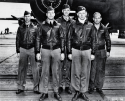 NS020884a |
704k | Plane #2. Serial #40-2292. Take off at 0825 Ship Time. Left to right: Lt. Carl R. Wildner, navigator; Lt. Travis Hoover, pilot; Lt. Richard E. Miller, bombardier; Lt. William N. Fitzhugh, co-pilot; SSgt. Douglas V. Radney, engineer/gunner. Target: Tokyo. Fate: Crash landed (China). |
||||||||||||||||
 NS020884b |
612k | Plane #3. Serial #40-2270 "Whisky Pete." Take off at 0830 Ship Time. Left to right: 2nd Lt. Charles J. Ozuk, Jr., navigator; Lt. Robert M. Gray, pilot; Sgt. Aden E. Jones, bombardier; 2nd Lt. Jacob E. "Shorty" Manch, co-pilot; Cpl. Leland D. Faktor (†), engineer/gunner. Target: Tokyo. Fate: Bailed out. |
||||||||||||||||
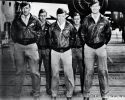 NS020884c |
636k | Plane #4. Serial #40-2282. Take off at 0833 Ship Time. Left to right: Lt. Harry C. McCool, navigator; Cpl. Bert M. Jordan, engineer/gunner; Lt. Everett W. "Brick" Holstrom, pilot; Sgt. Robert J. Stephens, bombardier; 2nd Lt. Lucian N. Youngblood, co-pilot. Target: Tokyo. Fate: Bailed out. |
||||||||||||||||
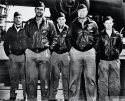 NS020884d |
703k | Plane #5. Serial #40-2283. Take off at 0837 Ship Time. Left to right: 2nd Lt. Eugene F. McGurl, navigator; Captain David M. Jones, pilot; 2nd Lt. Denver V. Truelove, bombardier; 2nd Lt. Rodney R. "Hoss" Wilder, co-pilot; Sgt. Joseph W. Manske, engineer/gunner. Target: Tokyo. Fate: Bailed out. |
Bob Canchola, BT, USN (Ret.) | |||||||||||||||
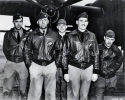 NS020884e |
628k | Plane #6. Serial #40-2298 "The Green Hornet." Take off at 0840 Ship Time. Left to right: 2nd Lt. Chase J. Nielsen, navigator; Lt. Dean E. Hallmark (executed by the Japanese), pilot; Cpl. Donald E. Fitzmaurice (†), engineer/gunner; 2nd Lt. Robert J. Meder (died in captivity), co-pilot; Sgt. William J. Dieter (†), bombardier. Target: Tokyo. Fate: Bailed out, POW. |
||||||||||||||||
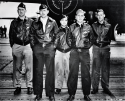 NS020884f |
692k | Plane #7. Serial #40-2261 "The Ruptured Duck." Take off at 0843 Ship Time. Left to right: 2nd Lt. Charles L. McClure, navigator; Lt. Ted W. Lawson, pilot; 2nd Lt. Robert S. Clever, bombardier; 2nd Lt. Dean Davenport, co-pilot; Sgt. David J. Thatcher, engineer/gunner. Target: Tokyo. Fate: Crash landed (China coast). |
||||||||||||||||
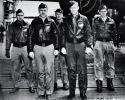 NS020884g |
741k | Plane #8. Serial #40-2242. Take off at 0846 Ship Time. Left to right: 2nd Lt. Nolan A. Herndon, navigator/bombardier; Capt. Edward J. York, pilot; SSgt. Theodore H. Laban, engineer; Lt. Robert G. Emmens, co-pilot; Sgt. David W. Pohl, gunner. Target: Tokyo. Fate: Landed and interned in the Soviet Union. |
||||||||||||||||
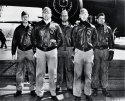 NS020884h |
663k | Plane #9. Serial #40-2303 "Whirling Dervish." Take off at 0850 Ship Time. Left to right: 2nd Lt. Thomas C. Griffin, navigator; Lt. Harold F. Watson, pilot; TSgt. Eldred V. Scott, engineer/gunner; 2nd Lt. James M. Parker, Jr., co-pilot; Sgt. Wayne M. Bissell, bombardier. Target: Tokyo. Fate: Bailed out. |
Bob Canchola, BT, USN (Ret.) | |||||||||||||||
 NS020884i |
628k | Plane #10. Serial #40-2250. Take off at 0853 Ship Time. Left to right: 2nd Lt. Horace E. "Sally" Crouch, navigator/bombardier; Lt. Richard O. Joyce, pilot; SStg. Edwin W. Horton, Jr., gunner; 2nd Lt. J. Roydon Stork, co-pilot; Sgt. George E. Larkin, Jr., engineer. Target: Tokyo. Fate: Bailed out. |
||||||||||||||||
 NS020884j |
687k | Plane #11. Serial #40-2249 "Hari Kari-er." Take off at 0856 Ship Time. Left to right: 2nd Lt. Frank A. Kappeler, navigator; Capt. Charles R. Greening, pilot; Sgt. Melvin J. Gardner, engineer/gunner; 2nd Lt. Kenneth E. Reddy, co-pilot; SSgt. William L. Birch, bombardier. Target: Yokohama. Fate: Bailed out. |
||||||||||||||||
 NS020884k |
700k | Plane #12. Serial #40-2278 "Fickle Finger." Take off at 0859 Ship Time. Left to right: 2nd Lt. William R. Pound, Jr., navigator; Lt. William M. Bower, pilot; SSgt. Omer A. Duquette, engineer/gunner; 2nd Lt. Thadd H. Blanton, co-pilot; TSgt. Waldo J. Bither, bombardier. Target: Yokohama. Fate: Bailed out. |
||||||||||||||||
 NS020884l |
679k | Plane #13. Serial #40-2247 "The Avenger." Take off at 0901 Ship Time. Left to right: 2nd Lt. Clayton J. Campbell, navigator; Lt. Edgar E. McElroy, pilot; Sgt. Adam R. Williams, engineer/gunner; 2nd Lt. Richard A. "Knobby" Knobloch, co-pilot; Sgt. Robert C. Bourgeois, bombardier. Target: Yokohama. Fate: Bailed out. |
Bob Canchola, BT, USN (Ret.) | |||||||||||||||
 NS020884m |
618k | Plane #14. Serial #40-2297. Take off at 0907 Ship Time. Left to right: 2nd Lt. James H. Macia, Jr., navigator/bombardier; Maj. John A. Hilger, pilot; SSgt. Jacob Eierman, engineer/gunner; 2nd Lt. Jack A. Sims, co-pilot; SSgt. Edwin V. Bain, radio/gunner. Target: Nagoya. Fate: Bailed out. |
||||||||||||||||
 NS020884n |
688k | Plane #15. Serial #40-2267 "TNT." Take off at 0915 Ship Time. Left to right: 2nd Lt. Howard A. Sessler, navigator/bombardier; Lt. Donald G. Smith, pilot; Lt. Thomas R. White, engineer; 2nd Lt. Griffith P. Williams, co-pilot; Sgt. Edward J. Saylor, gunner. Target: Nagoya. Fate: Ditched off China coast. |
||||||||||||||||
 NS020884o |
685k | Plane #16. Serial #40-2268 "Bat Out of Hell." Take off at 0919 Ship Time. Left to right: 2nd Lt. George Barr, navigator; Lt. William G. "Bill" Farrow (executed by the Japanese), pilot; Cpl. Harold A. Spatz (executed by the Japanese), engineer/gunner; Lt. Robert L. Hite, co-pilot; Cpl. Jacob D. DeShazer, bombardier. Target: Nagoya. Fate: Crash landed, POW. |
||||||||||||||||
 NS020819 |
41k | Army Lieut. Col. James H. Doolittle, taking off from USS Hornet (CV 8), Capt. Marc A. Mitscher commanding, bombed Tokyo, the first American air strike against the Japanese homeland. Hornet's mission was kept an official secret for a year; until then President Roosevelt referred to the origin of the Tokyo raid only as "Shangri-La." | USN | |||||||||||||||
 NS020820 |
444k | B-25s prepare to take off from USS Hornet (CV-8), 18 April 1942. The Americans bombed the cities of Tokyo, Nagoya and Kobe. Official U.S. Navy Photograph, now in the collections of the U.S. National Archives and Records Administration, photo # 80-G-324199. |
Gerd Matthers, Germany | |||||||||||||||
 NS020806 |
64k | April 18, 1942 photo shows the Hornet encountering rough seas while preparing to launch B-25 bombers for the Doolittle Raid on Japan. The cruiser on her port is the USS Vincennes (CA-44). Both ships were transferred from the Atlantic Fleet specifically for the Doolittle Raid. | USN | |||||||||||||||
 NS020806b |
113k | Enlarged version of photo above. | Steve Whitby | |||||||||||||||
 NS020826 |
126k | Army Air Corps and Navy enlisted personnel loading 50 Cal. ammunition aboard B-25's. | Steve Whitby | |||||||||||||||
 NS020807b |
80k | B-25B Mitchell (40-2344), 37th Bombardment Squadron, piloted by Lieutenant-Colonel Jimmy Doolittle taking off from the deck of the aircraft carrier USS Hornet (CV-8). Photo and text from Two Flights To Victory: From The Doolittle Raid To The Enola Gay, by David G. Styles. |
Robert Hurst | |||||||||||||||
 NS020807 |
1.33M | USS Hornet (CV-8) launches Army Air Force B-25B bombers, at the start of the first U.S. air raid on the Japanese home islands, 18 April 1942. Probably the most famous photo of the ship.
Photo in the collections of the National Archives and Records Administration (NARA), # 80-G-41197. |
Naval History & Heritage Command (NHHC) | |||||||||||||||
 NS020807a |
240k | USS Hornet (CV-8) underway during the Doolittle Raid, April 1942. Note USAAF North American B-25B Mitchells parked aft. Naval Aviation News, January–February 2007 issue, p. 32. |
Robert Hurst | |||||||||||||||
 NS020811 |
119k | An Army Air Forces B-25B bomber awaits the takeoff signal on the flight deck of USS Hornet (CV-8), as the raid is launched, 18 April 1942. Note Flight Deck Officer holding launch flag at right, and white stripes painted on the flight deck to guide the pilot's alignment of his plane's nose and port side wheels. Official U.S. Navy Photograph, now in the collections of the U.S. National Archives (photo # 80-G-41194). |
Scott Dyben | |||||||||||||||
 NS020812 |
113k | An Army Air Force B-25B bomber takes off from USS Hornet (CV-8) at the start of the raid, 18 April 1942. Note men watching from the signal lamp platform at right. Official U.S. Navy Photograph, now in the collections of the U.S. National Archives (photo # 80-G-41196). |
Scott Dyben | |||||||||||||||
 NS020812a |
433k | A U.S. Army Air Force North American B-25B Mitchell bomber taking off from the U.S. Navy aircraft carrier USS Hornet (CV-8) during the Doolittle Raid, 18 April 1942. U.S. Air Force photo, # 020930-O-9999G-008. |
Tommy Tranpp | |||||||||||||||
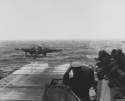 NS020812b |
294k | As above, a U.S. Army Air Force North American B-25B Mitchell bomber taking off from the U.S. Navy aircraft carrier USS Hornet (CV-8) during the Doolittle Raid, 18 April 1942. |
Bob Canchola, BT, USN (Ret.) | |||||||||||||||
 NS020830 |
78k | Color version of photo above. Inset: Lt. Col. James H. Doolittle, USAAFR, attaching Japanese medals to a 500 pound bomb to be dropped on Tokyo. The medals had been awarded to US Navy personnel before the war. |
Jack Treutle | |||||||||||||||
 NS020836 |
56k | Not very sharp but interesting stills taken from the color movie film showing USS Hornet launching the Doolittle raid. |
Pete Harlem | |||||||||||||||
 NS020836a |
54k | |||||||||||||||||
 NS020836b |
58k | |||||||||||||||||
 NS020846 |
95k | A USAAF B-25B bomber flies over USS Hornet (CV-8) while on its way to attack targets in Japan, just after it was launched on the morning of 18 April 1942. Naval History & Heritage Command photograph (#NH 53419). |
Gerd Matthes, Germany | |||||||||||||||
 NS020846a |
99k | USAAF B-25B bomber lines up for takeoff from USS Hornet (CV-8), on the morning of 18 April 1942. Note white lines painted on the flight deck, below the plane's nose and port side wheels, to guide the pilot during his takeoff run. This is the 3rd or 4th plane to be launched. Naval History & Heritage Command photograph (#NH 53420). |
Gerd Matthes, Germany | |||||||||||||||
 NS020846b |
70k | USAAF B-25B bombers prepare to take off from USS Hornet (CV-8), on the morning of 18 April 1942. These are the last five or six planes to be launched. Naval History & Heritage Command photograph (#NH 53435). |
Gerd Matthes, Germany | |||||||||||||||
 NS020846c |
224k | "Colonel Jimmy Doolittle leads his team of 16 B-25 Mitchell bombers off the heaving deck of the U.S. carrier Hornet bound for Tokyo on the morning of April 18th." Painting by aviation artist Nicolas Trudgian. |
Courtesy of Nicolas Trudgian | |||||||||||||||
 NS020846f |
51k | USS Hornet (CV-8), Doolittle Raid, Marshall Islands post stamp. |
Tommy Trampp | |||||||||||||||
 NS020846g |
61k | Doolittle Raiders patch. |
||||||||||||||||
 NS020846e |
1.30M | A U.S. Army Air Force B-25B Mitchell medium bomber, one of 16 involved in the Doolittle Raid, takes off from the flight deck of USS Hornet for an air raid on Japan, 18 April 1942. U.S. Army Air Force photo, VIRIN: 420418-O-ZZ999-001. |
Bob Canchola, BT, USN (Ret.) | |||||||||||||||
 NS020846d |
423k | The aircraft carriers USS Hornet (CV-8), foreground, and USS Enterprise (CV-6), eastward bound after launching the Doolittle raid on Japan, 18 April 1942. Hornet's air group has already been respotted on the flight deck in this photo, taken from the heavy cruiser USS Salt Lake City (CA-25). Official US Navy photograph, now in the collections of the National Archives and Records Administration (NARA), photo # 80-G-324201. |
Courtesy of Mahlon Miller, Facebook
Carriers! Group, via Gordon Buttars |
|||||||||||||||
 NS020845 |
3.87M | Doolittle Raid, 18 April 1942. |
Author unknown. Submitted by Ralph Hiestand, Ron Reeves and Stanley Svec |
|||||||||||||||
 NS020863 |
112k | Lieutenant Colonel James H. Doolittle, USAAF, (center) with members of his flight crew and Chinese officials in China after the 18 April 1942 attack on Japan. Those present are (from left to right): Staff Sergeant Fred A. Braemer, Bombardier; Staff Sergeant Paul J. Leonard, Flight Engineer/Gunner; General Ho, director of the Branch Government of Western Chekiang Province; Lieutenant Richard E. Cole, Copilot; Lt.Col. Doolittle, Pilot and mission commander; Henry H. Shen, bank manager; Lieutenant Henry A. Potter, Navigator; Chao Foo Ki, secretary of the Western Chekiang Province Branch Government. Official U.S. Army Air Forces Photograph, from the collections of the Naval History & Heritage Command (# 97502). |
NH&HC. | |||||||||||||||
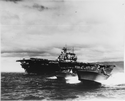 NS020821 |
162k | USS Hornet (CV-8) arrives at Pearl Harbor after the Doolittle Raid on Japan, 30 April 1942. Two Squadron 1, 77' Elco boats, PT-28 and PT-29 are speeding by in the foreground. NS020821: Official U.S. Navy Photograph, now in the collections of the U.S. National Archives and Records Administration (NARA), # 80-G-16865. |
NH&HC | |||||||||||||||
 NS020821a |
153k | Ron Titus | ||||||||||||||||
 NS020832 |
51k | Lt. General James H. Doolittle and 25th Anniversary Plaque, U.S. Naval Air Station Alameda, 18 April 1967 (color photo taken in 1974). "The last CO of NAS Alameda THANK GOD had the foresight in the waning days of the base to have his troops cut it off at the angle irons and put it in storage until a base museum could be established and it was eventually put on display in the old passenger terminal bldg now called the NAS Alameda Base Museum." |
Photos and information thanks to Ron Jensen, via Ron Reeves | |||||||||||||||
 NS020832a |
336k | |||||||||||||||||
 NS020837 |
153k | Washington, D.C., Nov. 9, 2006 — Surviving members of the Doolittle Raiders paid tribute to the U.S. Navy and USS Hornet (CV-8) during a wreath laying ceremony at the Navy Memorial. U.S. Air Force photo by Staff Sgt. Madelyn Waychoff (# 061109-F-0000X-001). |
USN | |||||||||||||||
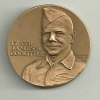 NS020848 |
21k | Medal to commemorate Doolittle's Raid on Tokyo, April 18, 1942 (obverse and reverse). |
Robert M. Cieri | |||||||||||||||
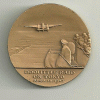 NS020848a |
23k | |||||||||||||||||
 NS020876 |
372k | Republic of the Marshall Islands, Five Dollars. To the Heroes of the Raid on Tokyo, 1942–1992. |
Tommy Trampp | |||||||||||||||
 NS020849 |
148k | Native Sons of the Golden West plaque, dedicated December 7, 2007. |
Robert M. Cieri | |||||||||||||||
NS020850 |
268k | "Alameda and the Doolittle Raid," Alameda Sun, 14 April 2011. |
Robert M. Cieri | |||||||||||||||
 NS020859 |
314k | "Doolittle Raiders hold reunion on Hornet," Alameda Journal, 20 October 2000. |
Robert M. Cieri | |||||||||||||||
 NS020859a |
299k | |||||||||||||||||
 NS020871 |
240k | Task Force 16 Commendation for Lieutenant Commander Richard J. Nowatzki, USN (Ret.), signed by Secretary of the Navy John H. Dalton , 15 May 1995. |
Bob Fish, Trustee, USS Hornet Museum |
|||||||||||||||
 NS020880 |
461k | Certificate of Recognition, United States Congress, Congressional Gold Medal, To the Officers and Crew of the USS Hornet CV-8. Confirmed, 18 April 2015. |
Bob Fish, Trustee, USS Hornet Museum |
|||||||||||||||
 NS020880a |
246k | "Doolittle Tokyo Raiders, First Strike, April 18, 1942." "17th Bombardment Group, Toujours au Danger, 34th, 37th, 89th, 95th, Act of Congress 2014" |
||||||||||||||||
| "Saluting the Doolittle Raid," USS Hornet Museum Living Ship Day, April 21, 2007 | ||||||||||||||||||
 NS020856 |
25k | Douglas TBD Devastator, Aircraft #5 of Torpedo Squadron 8 aboard the aircraft carrier USS Hornet (CV-8), May 1942. |
Courtesy of Scott Koen & ussnewyork.com | |||||||||||||||
 NS020856a |
26k | Douglas TBD Devastator, Aircraft #3 of Torpedo Squadron 8 aboard the aircraft carrier USS Hornet (CV-8), May 1942. |
||||||||||||||||
 NS020874 |
708k | "Hornet at Pearl Harbor between the Battles of the Coral Sea and Midway. The Measure 12 camouflage she brought from the Atlantic is still intact, and the apparent deterioration along the waterline is actually a very complex attempt at a fake bow wave (Measure 5), intended to create a false impression of speed. (USN)" From Stern, Robert C., "The US Navy in World War Two, 1941–1942," Warships Illustrated, No. 10 (Published by Arms and Armour Press, London, 1987). |
Gerd Matthes, Germany | |||||||||||||||
 NS020888 |
303k | Grumman F4F-4 Wildcat fighters of Fighting Squadron (VF) 8 launching from USS Hornet (CV-8), circa May–June 1942. National Naval Aviation Museum photo, # 1996.253.7386.035. |
Robert Hurst | |||||||||||||||
| Battle of Midway, June 1942 |
||||||||||||||||||
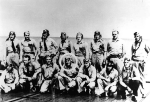 NS0630801 |
181k | Torpedo Squadron Eight (VT-8) pilots photographed aboard USS Hornet (CV-8), circa mid-May 1942, shortly before the Battle of Midway. They are (Front row, kneeling, left to right): Ensign Harold J. Ellison; Ensign Henry R. Kenyon; Ensign John P. Gray; Ensign George H. Gay, Jr.; Lieutenant (Junior Grade) Jeff D. Woodson; Ensign William W. Creamer; Aviation Pilot First Class Robert B. Miles. (Back row, standing, left to right): Lieutenant James C. Owens, Jr.; Ensign E.L. Fayle; Lieutenant Commander John C. Waldron, Squadron Commanding Officer; Lieutenant Raymond A. Moore; Ensign Ulvert M. Moore; Ensign William R. Evans; Ensign Grant W. Teats; Lieutenant (Junior Grade) George M. Campbell. Courtesy of the U.S. Naval Institute, Annapolis, MD. Naval History & Heritage Command photo (# NH 93595). |
Bill Gonyo | |||||||||||||||
 NS020861 |
105k | Aerial view of USS Hornet (CV-8) taken from film footage shot during the Battle of Midway. |
Michael Vorrasi | |||||||||||||||
 NS020851 |
109k | Douglas SBD Dauntless, Aircraft 11 of Bombing 8 aboard the aircraft carrier USS Hornet (CV-8) being manhandled across the carrier's flight-deck. Note the mixture of old-style and new-style helmets at this stage of the war, and the freshly painted white star on the Dauntless, now with no trace at all or any hint of the "red meatball," illustrating the dominance of the rising sun marking in the spring of 1942. Photo courtesy of Clayton Fisher. Photos and text from Midway: Dauntless Victory, by Peter C. Smith. |
Robert Hurst | |||||||||||||||
 NS020854 |
117k | An SBD-3 Dauntless of Bombing Squadron 8 (VB-8) flies right over the head of the Landing Signal Officer during the recovery aboard USS Hornet (CV-8). VB-8 operated from the carrier during the Battle of Midway on 4 June 1942, but did not locate the Japanese Fleet. Three aircraft were forced to ditch, but the six crewmen were all rescued. On 6 June 1942, elements of the squadron successfully hit the Japanese cruiser Mogami, losing one aircraft and its crew. Robert L. Lawson photograph collection. US Navy and Marine Corps Museum, Photo No. 1996.253.647. |
Mike Green | |||||||||||||||
 NS020822 |
61k | USS Hornet (CV-8) underway in the Southern Pacific, 15 May 1942, a week after the Battle of Coral Sea and the day before she was recalled to Pearl Harbor to prepare for the Battle of Midway. Official U.S. Navy Photograph, now in the collections of the U.S. National Archives. (photo # 80-G-14866). |
NHC | |||||||||||||||
 NS020813 |
122k | USS Hornet (CV-8) enters Pearl Harbor, 26 May 1942. She left two days later to take part in the Battle of Midway. Photographed from Ford Island Naval Air Station, with two aircraft towing tractors parked in the center foreground. Official U.S. Navy Photograph, now in the collections of the U.S. National Archives (photo # 80-G-66132). |
Scott Dyben | |||||||||||||||
 NS020814 |
71k | USS Hornet (CV-8) at Pearl Harbor, 26 May 1942, just after the Battle of Coral Sea, and just before the Battle of Midway. Harbor tug Nokomis (YT-142) is underway alongside her. Note paint chipped off Hornet's waterline area by wave action while at sea. Official U.S. Navy Photograph, now in the collections of the U.S. National Archives (photo # 80-G-66129). |
Scott Dyben | |||||||||||||||
 NS020827 |
99k | Hornet tied up at Ford Island, Pearl Harbor, May 27th, 1942. All three of the class, Yorktown, Enterprise and Hornet were there before departing for Midway. | Steve Whitby | |||||||||||||||
 NS020887 |
138k | U.S. Navy Grumman F4F-4 Wildcat fighters of Fighting Squadron (VF) 8 launching from the aircraft carrier USS Hornet (CV-8), circa May–June 1942. The first aircraft (F-9) was piloted by ENS Charles M. Kelly, Jr., USNR. After a fruitless search for the Japanese fleet on 4 June 1942, his plane ran out of fuel and ditched; he could not be rescued. U.S. Navy photograph from maritimequest.com. |
Robert Hurst | |||||||||||||||
 NS020551 |
74.8Mb | "The Battle of Midway," directed by John Ford and narrated by Henry Fonda, is comprised mostly of authentic footage from the battle. This documentary, produced in 1942, won an Academy Motion Picture Arts and Sciences Award (Oscar). Then Commander (later Rear Admiral) John Ford, USNR, in civil life wrote, directed or produced more than 130 films in a career spanning four decades. Format: MP4 (.mp4) Duration: 18' 7" Size: 320 x 240 Download a free MP4 player. Another collection of footage taken by John Ford is available at Live Leak. |
Courtesy of Internet Archive. Thanks to Ron Reeves for the clue. | |||||||||||||||
 NS020868 |
143k | A U.S. Navy Douglas SBD-3 Dauntless of either scouting squadron VS-8 or bombing squadron VB-8 recovering aboard USS Hornet (CV-8), probably during the Battle of Midway, 4–6 June 1942. National Naval Aviation Museum photo (# 1996.253.650). |
Alex Tatchin | |||||||||||||||
 NS020852 |
74k | A Douglas TBD-1 Devastator from the ill-fated Torpedo Eight begins its take-off run off USS Hornet (CV-8). This plane was the twelfth of fifteen TBD's (probably ENS William R. Evans, Jr., A-V(N) USNR, and Ross E. Bibb, Jr., ARM3c, in T-4, BuNo 0321) launched by VT-8 on the morning of 4 June. Photo courtesy Mark Horan. | Robert Hurst | |||||||||||||||
 NS020852a |
180k | The last Douglas TBD-1 Devastator of U.S. Torpedo Squadron (VT) 8, T-16 (BuNo 1506), flown by LCDR John C. Waldron with Horace Franklin Dobbs, CRMP, in the rear seat, taking off from the aircraft carrier USS Hornet (CV-8) on 4 June 1942, during the Battle of Midway. Note the unstowed twin 0.30 cal mgs. Photo courtesy of Mark Horan. | ||||||||||||||||
 NS020852b |
58k | The ill-fated Torpedo Eight, led by F4F Wildcats, forms up prior to departure from USS Hornet (CV-8) on the morning of 4 June 1942. The last known photograph of the unit in battle formation, taken by the official Hornet photographer, William B. Gibson. Photo © William B. Gibson. | ||||||||||||||||
 NS020852c |
271k | Presidential Unit Citation presented to Torpedo Squadron Eight "[f]or extremely heroic and courageous performance in combat during the 'Air Battle of Midway,' June 4, 1942." This copy was given to the family of Ensign Harold J. Ellison, a pilot with Torpedo Squadron (VT) 8, who was posthumously awarded the Navy Cross. |
Courtesy of the National Naval Aviation Museum via Bill Gonyo | |||||||||||||||
 NS020858 |
42k | On Thursday, 4 June 1942, during operations near Midway Island, an F4F-4 Wildcat, # 3-F-24, from VF-3—USS Yorktown (CV-5)—, piloted by Ensign Daniel Sheedy, accidentally fired its .50-cal machine guns while landing on USS Hornet (CV-8). ENS Sheedy had been wounded during the battle and the controls to safe the guns had been shot out, according to eye-witness acounts. Five Hornet crewmembers were killed (one of them LT Royal R. Ingersoll II, son of ADM Royal E. Ingersoll and grandson of RADM Royal R. Ingersoll) and 20 others wounded in this accident. See Researcher @ Large for the complete Damage Report, along with photographs and comments. |
Courtesy of Tracy White, Researcher @ Large | |||||||||||||||
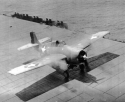 NS020858a |
94k | A U.S. Navy Grumman F4F-4 Wildcat of Fighting Squadron (VF) 3 from USS Yorktown (CV-5) lands on the aircraft carrier USS Hornet (CV-8), circa 1329, 4 June 1942. Plane "3-F-5" was piloted by ENS. Horace A. Bass, Jr.,according to some sources, or by LT(JG) William W. Barnes (who was awarded the Navy Cross for his combat actions on this day), according to other sources. As had been the case with ENS Sheedy's aircraft (above), the Wildcat's guns opened fire, but their bullets zipped over Hornet's port side without harming anyone. |
Robert Hurst | |||||||||||||||
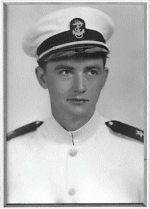 NS0644601 |
31k | Ensign Charles E. Brannon, known as Charlie to his friends, was one of the pilots killed from VT-8 during the Battle of Midway. For his bravery that day he was awarded the Navy Cross and the Purple Heart posthumously. His story is one of the little told events of the Battle of Midway. He was part of a 6-crew detachment that flew from the Island of Midway instead of USS Hornet (CV-8) that day. Of the 6 TBF's that took off from Midway Island 4 June 1942 to find and attack the Japanese, only one plane made it back to Midway carrying 2 wounded crewmen and 1 killed in action. When the TBF Grumman Avenger became available, some crews of VT-8 were detached from the main squadron to train in the new plane, while the main group continued to fly the TBD Devastator off the USS Hornet. VT-8 was the first squadron in the US Navy to be able to fly the Avenger and the first to take her into combat. Most of the TBF detachment stayed in Hawaii during the battle, however 6 of the crews were sent to Midway to help bolster the defenses of the Island. ENS Brannon was one of the men hand selected for the task by LT Larsen. At 0600, 4 June 1942, Ensign Brannon and his crew (Charles E. Fair and William C. Lawe) took off from Midway to attack the Japanese. At 0700 they found them. LT Langdon K. Fieberling led his men in an attack on the ships and the rest is history. Only one plane flown by ENS Albert K. Earnest survived to tell the story of what had happened to the 6-plane force. Later the same day LCDR John C. Waldron led the main section of VT-8 in an attack on the Japanese fleet with equally grim results. Only ENS George Gay survived. His story is well-known by students of history. In 1944 a Destroyer Escort, USS Charles E. Brannon (DE-446) was commissioned, named for him. CITATION "The President of the United States takes pride in presenting the Navy Cross (Posthumously) to Charles E. Brannon (0-105955), Ensign, U.S. Navy (Reserve), for extraordinary heroism in operations against the enemy while serving as Pilot of a carrier-based Navy Torpedo Plane of Torpedo Squadron EIGHT (VT-8), embarked from Naval Air Station Midway during the 'Air Battle of Midway,' against enemy Japanese forces on 4 and 5 June 1942. In the first attack against an enemy carrier of the Japanese invasion fleet, Ensign Brannon pressed home his attack in the face of withering fire from enemy Japanese fighters and anti-aircraft forces. Because of events attendant upon the Battle of Midway, there can be no doubt that he gallantly gave up his life in the service of his country. His courage and utter disregard for his own personal safety were in keeping with the highest traditions of the United States Naval Service. He gallantly gave his life for his country." Bureau of Naval Personnel Information Bulletin No. 310 (January 1943)" |
Bill Gonyo | |||||||||||||||
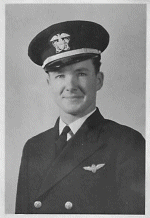 NS0653501 |
26k | Victor Alan Lewis was born in Sommerville, Massachusetts, to Mr. and Mrs. Murry Lewis of 245 Allen Street, Randolph, Massachusetts, on August 2, 1919. He graduated from Stetson High School in Randolph, and attended Springfield College, where he was active in athletics, including varsity track and gymnastics. He also coached track, swimming, tennis, and gymnastics. He enlisted in the United States Navy Reserve as a Seaman second class at Squantum Naval Reserve Aviation Base, Boston, Massachusetts, February 17, 1941. In April 1941, he was transferred to Naval Air Station, Jacksonville, Florida, where he accepted an appointment as Aviation Cadet. He did advanced flight training at Jacksonville and Miami and was designated Naval Aviator on December 1st, 1941. He was promoted to Ensign with a date of rank of October 14, 1941. He was transferred to Naval Air Station, Norfolk, Virginia, for further training with Advanced Carrier Training Group, Atlantic Fleet. In February 1942, he was assigned to Torpedo Squadron 8 aboard USS Hornet (CV-8) in the Pacific area. Ensign Lewis was reported as missing in action on June 4th, 1942, during the Battle of Midway, along with his radioman AM3c Nelson L. Carr and turret gunner EM3c John W. Mehltretter. He was posthumously awarded the Navy Cross and Purple Heart. The John C. Butler-class Destroyer Escort USS Lewis (DE-535) was named and commissioned in his honor on 5 September 1944. CITATION "The President of the United States of America takes pride in presenting the Navy Cross (Posthumously) to Ensign Victor Alan Lewis (NSN: 0-106252), United States Naval Reserve, for extraordinary heroism in operations against the enemy while serving as Pilot of a carrier-based Navy Torpedo Plane of Torpedo Squadron EIGHT (VT-8), embarked from Naval Air Station Midway during the 'Air Battle of Midway,' against enemy Japanese forces on 4 and 5 June 1942. In the first attack against an enemy carrier of the Japanese invasion fleet, Ensign Lewis pressed home his attack in the face of withering fire from enemy Japanese fighters and anti-aircraft forces. Because of events attendant upon the Battle of Midway, there can be no doubt that he gallantly gave up his life in the service of his country. His courage and utter disregard for his own personal safety were in keeping with the highest traditions of the United States Naval Service. He gallantly gave his life for his country." General Orders: Bureau of Naval Personnel Information Bulletin No. 313 (April 1943) |
Bill Gonyo | |||||||||||||||
 NS020885 |
824k | Captain (then Ensign) Albert "Bert" K. Earnest was awarded three Navy Crosses while serving with Torpedo Squadron (VT) 8 during World War II. |
Bill Gonyo/NavSource | |||||||||||||||
NS020853 |
62k | USS Hornet (CV-8) at the Battle of Midway, with F4F Wildcats aft on her flight deck. Heavy cruiser USS Vincennes (CA-44) is to the right, and light, anti-aircraft cruiser USS Atlanta (CL-51) in the foreground. U.S. Navy photo. | Robert Hurst | |||||||||||||||
 NS020853a |
123k | Battle of Midway, 4–7 June 1942. Destroyer USS Phelps (DD-360) ran short of fuel, light cruiser USS Atlanta (CL-51) came up and offered assistance to the destroyer, 6 June. However, Phelps resumed her position shortly afterwards without requiring outside help. Heavy cruiser USS Vincennes (CA-44) is in the background. U.S. Navy photograph, now in the collections of the National Archives and Records Administration (NARA), # 80-G-7750. |
NH&HC | |||||||||||||||
 NS020862 |
170k | The Japanese "heavy cruiser IJNS Mikuma after heavy air attacks by SBDs from USS Enterprise and USS Hornet on 6 June 1942. This photograph was taken from the Hornet's combat file (serial 0018) and shows smoke from three different bomb hits pouring away from her. This photograph has never been published before and is also the only one that shows the two destroyers IJNS Arashio and IJNS Asashio in position upwind of the crippled ship in her last hours. Photo courtesy NARA, Washington DC." Photos and text from Midway: Dauntless Victory, by Peter C. Smith. |
Robert Hurst | |||||||||||||||
 NS020864 |
86k | Ensign George H. Gay at Pearl Harbor Naval Hospital, with a nurse and a copy of the Honolulu Star-Bulletin newspaper featuring accounts of the Battle of Midway. He was the only survivor of the 4 June 1942 Torpedo Squadron Eight (VT-8) TBD torpedo plane attack on the Japanese carrier force. Gay's book Sole Survivor indicates that the date of this photograph is probably 7 June 1942, following an operation to repair his injured left hand and a meeting with Admiral Chester W. Nimitz. Official U.S. Navy photograph, now in the collections of the U.S. National Archives (# 80-G-17678). |
Naval History & Heritage Command | |||||||||||||||
 NS020864a |
87k | Ensign George H. Gay (left) and Lieutenant (Junior Grade) Elbert S. McCuskey, with the latter's F4F-4 Wildcat fighter, June 1942, following the Battle of Midway. Note seven "victory" flags painted below the cockpit. Ensign Gay was the sole Battle of Midway aircrew survivor of USS Hornet's Torpedo Squadron Eight. During the battle, McCuskey served with USS Yorktown's Fighting Squadron Three. Courtesy of the U.S. Naval Institute, Annapolis, MD. Naval History & Heritage Command photo (# NH 90482). |
Naval History & Heritage Command | |||||||||||||||
 NS020864b |
1.40M | "Attack—and Vengeance! The Story of Torpedo 8" "'If God arranged everything to fall into the right place now, the carrier, all the planes using it, the Japs in their airplanes and submarines, the weather and the wind—'Photo shows Navy plane coming home after a combat mission in the Pacific—Official U.S. Navy Photo." The Evening Star, Washington D.C., Wednesday, 21 April 1943. |
Chronicling America, via Michael Mohl |
|||||||||||||||
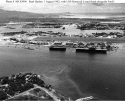 NS0300110 |
125k | Pearl Harbor, Oahu, Territory of Hawaii. View looking eastward from over Pearl City, with Ford Island in the middle of the view and Diamond Head in the distant center, 1 August 1942. USS Long Island (AVG-1) and USS Hornet (CV-8) are moored along Ford Island's western side, protected by anti-torpedo nets. The capsized hull of USS Utah (AG-16), a victim of the 7 December 1941 Japanese air raid, is astern of Long Island. Courtesy of the Naval Historical Foundation. Collection of The Honorable James V. Forrestal. Official U.S. Navy Photograph, from the collections of the Naval Historical Center (# NH 83996). |
Naval History & Heritage Command | |||||||||||||||
 NS020855 |
241k | USS Hornet (CV-8) with her post-Midway refit modifications. Pearl Harbor, Territory of Hawaii, June–August 1942. Note the pattern of her Measure 12 (Modified) camouflage. National Archives and Records Administration (NARA) photo, # 80-G-K-439. |
Michael Vorrasi Michael Mohl |
|||||||||||||||
| Battle of the Santa Cruz Islands, October 1942 |
||||||||||||||||||
 NS020808d |
520k | At 0910, 26 October 1942, Japanese Val dive bombers and Kate torpedo planes attacked the American force through a wall of F4F Wildcats and anti-aircraft fire. USS Hornet (CV-8) took the first bomb hit of her short life on the starboard side of the flight deck, aft, and two near misses off the starboard bow. Official U.S. Navy Photograph, now in the collections of the U.S. National Archives and Records Administration (NARA), photo # 80-G-33927. |
Robert M. Cieri. |  NS020808 |
471k | A Japanese Type 99 shipboard bomber (Allied codename "Val") trails smoke as it dives toward USS Hornet (CV-8), during the morning of 26 October 1942. This plane struck the ship's stack and then her flight deck. A Type 97 shipboard attack plane ("Kate") is flying over Hornet after dropping its torpedo, and another "Val" is off her bow. Note anti-aircraft shell burst between Hornet and the camera, with its fragments striking the water nearby. Official U.S. Navy Photograph, now in the collections of the U.S. National Archives (photo # 80-G-33947). |
Scott Dyben Bob Canchola, BT, USS Oriskany, 1971‑1973. |
 NS0405228 |
2.99M | During the Battle of the Santa Cruz Islands, USS Hornet (CV-8) is seen dead in the water as USS Northampton (CA-26) attempts to take her in tow. Cruisers USS Pensacola (CA-24), and USS Juneau (CL-52) maneuver around the carrier. Note after guns of the light cruiser trained on camera plane. National Archives and Records Administration photo, # 80-G-304513. Shortly before noon on 26 October 1942, Hornet's Avengers were returning to the carrier only to find she was dead in the water. The torpedo-bombers were signaled to head for USS Enterprise (CV-6). The observers on Juneau intercepted the signal and, thinking it was intended for them, proceeded towards Enterprise. The photographer onboard CDR Rodee's Avenger took several photos of Hornet as they circled the ship. This image captures Juneau just as she was about to head for Enterprise and TF-16. Juneau was identified based on several configuration items that differed from USS San Diego (CL-53), which was also part of TF-17. |
Rick Davis | 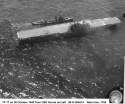 NS020808a |
3.37M | The damaged U.S. Navy aircraft carrier USS Hornet (CV-8) with the destroyer USS Mustin (DD-413) alongside, during the Battle of Santa Cruz Islands, at 1155, 26 October 1942. The photo was taken by a cameraman on a TBM Avenger from Hornet. National Archives and Records Administration photo, # 80-G-304514. |
Robert Hurst Detailed information provided by Rick E. Davis |
 NS020808e |
200k | During the Battle of the Santa Cruz Islands, USS Northampton (CA-26) and USS Russell (DD-414) standing by the crippled USS Hornet (CV-8). Note oil slick around the carrier. National Archives and Records Administration photo, # 80-G-304517. |
Mike Green |  NS020808b |
97k | The damaged U.S. Navy aircraft carrier USS Hornet (CV-8) with the destroyer USS Mustin (DD-413) nearby, during the Battle of Santa Cruz Islands, 26 October 1942. U.S. Navy photo from the USS Russell (DDG-59) commissioning book. |
Robert Hurst |  NS020808c |
77k | This photo, taken from U.S. Navy destroyer USS Russell (DD-414), shows another destroyer—probably USS Morris (DD-417), based on the camo pattern worn—approaching the damaged aircraft carrier USS Hornet (CV-8) during the Battle of the Santa Cruz Islands, 26 October 1942. U.S. Navy photo from the USS Russell (DDG-59) commissioning book. (Additional information thanks to Rick E. Davis.) |
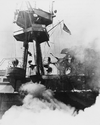 NS020809 |
161k | Damage to the smokestack and signal bridge of USS Hornet (CV-8) after it was struck by a crashing Japanese dive bomber, during the morning of 26 October 1942. Smoke at bottom is from fires started when the plane subsequently hit the flight deck. Note ship's tripod mast, with CXAM radar antenna in top left and the flag still flying above the damaged structure. Official U.S. Navy Photograph, now in the collections of the U.S. National Archives (photo # 80-G-40300). |
Scott Dyben | |||||||||||||||
 NS020809a |
183k | Battle of the Santa Cruz Islands, October 1942. Fire-fighting crews try to extinguish flames on board USS Hornet (CV-8) after she was struck by a crashing Japanese dive bomber, during the morning of 26 October 1942. Hornet sank later that day. National Archives and Records Administration (NARA) photo, # 80-G-40301. |
NARA | |||||||||||||||
 NS0402627 |
496k | USS Northampton (CA-26), at left, off the port bow of USS Hornet (CV-8) after the carrier had been disabled by Japanese air attacks. |
Fred Branyan | |||||||||||||||
NS0541427 |
58k | "Our final large carrier loss of the war. USS Hornet sinks in the Santa Cruz action. Her remarkable hull toughness absorbed many enemy torpedo, bomb, and suicide plane hits and American torpedo and gunfire scuttling attempts. Four Japanese torpedoes finally destroyed her. Here the USS Russell leads other American destroyers to the work of damage control, fire-fighting and rescue." From United States Destroyer Operations in World War II, by Theodore Roscoe. |
Robert Hurst | |||||||||||||||
 NS0402604 |
103k | USS Northampton (CA-26), at right, attempting to tow USS Hornet (CV-8) after she had been disabled by Japanese air attacks on 26 October 1942. Official U.S. Navy Photograph, now in the collections of the National Archives (# 80-G-33897). |
Scott Dyben | |||||||||||||||
 NS020815 |
316k | October 26 1942, Hornet in tow. Cruiser Northampton (CA-26) made three attempts to take the carrier in tow, but additional Japanese attacks frustrated these efforts. The "X" above the bridge and the CXAM radar antenna indicates where T.R. Archer was wounded by a Japanese dive bomber in a suicide attack (see photos "020808" and "020809", above). |
From the collection of Chief Parachute Rigger, Theo. R. Archer, USN Retired. Contributed by his son, Bill Archer. | |||||||||||||||
|
Images from the USS Northampton (CA-26) After Action Report Submitted by Rick E. Davis.
|
||||||||||||||||||
 NS020815f |
752k | Battle of Santa Cruz Islands, 26 October 1942. USS Hornet (CV-8) after the damage done by Japanese planes. Artwork by John Hamilton from his publication, War at Sea, pg. 159.
Navy Art Gallery, # 80-142-AG. |
Courtesy of the U.S. Navy Art Gallery | |||||||||||||||
 NS020816 |
322k | October 26 1942, Hornet being abandoned. |
From the collection of Chief Parachute Rigger, Theo. R. Archer, USN Retired. Contributed by his son, Bill Archer. | |||||||||||||||
 NS020817 |
327k | October 26 1942, Hornet being abandoned. About 900 crewmen had been transferred to accompanying destroyers when, at 1523, Hornet took another torpedo on her starboard side. At 1550 the order to abandon ship was passed. |
From the collection of Chief Parachute Rigger, Theo. R. Archer, USN Retired. Contributed by his son, Bill Archer. | |||||||||||||||
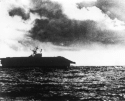 NS020817a |
34k | USS Hornet (CV-8), severely listing, is abandoned by her crew at about 1700 hrs, 26 October 1942, during the Battle of the Santa Cruz Islands. |
Bob Canchola, BT, USS Oriskany, 1971‑1973. |
|||||||||||||||
 NS020818 |
148k | Chief Parachute Rigger, Theo. R. Archer, USN, on flight deck of USS Hornet (CV-8), 1942. He was on her from commission till sunk. |
From the collection of Chief Parachute Rigger, Theo. R. Archer, USN Retired. Contributed by his son, Bill Archer. | |||||||||||||||
 NS020866 |
8.60M | USS Hornet (CV-8) Loss in Action, Santa Cruz, 26 October 1942. Photos from the Bureau of Ships WAR DAMAGE REPORT No. 30, dated 8 July 1943. NOTE: This is an imitation, not a facsimile, of the original document. |
Images submitted by Mike Green. | |||||||||||||||
 NS020866a |
5.59M | USS Hornet (CV-8) Loss in Action, Santa Cruz, 26 October 1942. Damage diagrams from the Bureau of Ships WAR DAMAGE REPORT No. 30, dated 8 July 1943. |
Mike Green. | |||||||||||||||
 NS020879 |
139k | The wreckage of Hornet was found in January 2019 at the bottom of the South Pacific Ocean, around the Solomon Islands, some 17,500 feet (5,334 meters) below the surface, by the late Paul G. Allen's R/V Petrel. One of Hornet's 5-inch guns. (Read "Final Resting Place of USS Hornet CV-8 Located in South Pacific," at the US Navy website.) |
Courtesy Navigea Ltd., via Michael Mohl |
|||||||||||||||
| Models |
||||||||||||||||||
 NS020823 |
108k | Model on display at the National Naval Aviation Museum, Pensacola, Florida. Photos taken on 13 June 2008. |
Photos by Judson Phillips | |||||||||||||||
 NS020823a |
108k | |||||||||||||||||
 NS020823b |
84k | |||||||||||||||||
 NS020823c |
76k | |||||||||||||||||
NS020870 |
104k | This is a 60" model of USS Hornet (CV-8) at the time of the Doolittle Raid, April 1942. All B-25s are numbered correctly and there are F4Fs in the hangar. |
Courtesy of Joel Rosen, Motion Models | |||||||||||||||
 NS020870a |
136k | |||||||||||||||||
NS020870b |
96k | |||||||||||||||||
 NS020870c |
144k | |||||||||||||||||
 NS020870d |
53k | |||||||||||||||||
 NS020870e |
67k | |||||||||||||||||
 NS020870f |
70k | |||||||||||||||||
 NS020870g |
57k | |||||||||||||||||
 NS020870h |
46k | This is a 60" model of USS Hornet (CV-8) at the time of the Doolittle Raid, April 1942. All B-25s are numbered correctly and there are F4Fs in the hangar. |
Courtesy of Joel Rosen, Motion Models | |||||||||||||||
 NS020870i |
53k | |||||||||||||||||
 NS020870j |
65k | |||||||||||||||||
 NS020870k |
61k | |||||||||||||||||
 NS020870l |
70k | |||||||||||||||||
 NS020870m |
42k | |||||||||||||||||
 NS020870n |
48k | |||||||||||||||||
 NS020870o |
45k | |||||||||||||||||
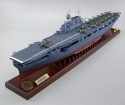 NS020870p |
218k | This is a 60" model of USS Hornet (CV-8) at the time of the Doolittle Raid, April 1942. All B-25s are numbered correctly and there are F4Fs in the hangar. |
Courtesy of Joel Rosen, Motion Models | |||||||||||||||
 NS020870q |
154k | |||||||||||||||||
 NS020870r |
191k | |||||||||||||||||
 NS020870s |
146k | |||||||||||||||||
 NS020870t |
108k | |||||||||||||||||
 NS020870u |
146k | |||||||||||||||||
 NS020873 |
805k | Model of USS Hornet (CV-8), showing B-25B Mitchell medium bombers used for the Doolittle Raid on Japan. |
Photos ©John C. Driskill, used with permission | |||||||||||||||
 NS020873a |
558k | |||||||||||||||||
NS020889 |
9.26M | A 30-photo set of a beautiful model of USS Hornet (CV-8), meticulously built by Ivan Víšek in the Czech Republic. |
Ivan Víšek | |||||||||||||||
| USS Hornet in the Movies |
||||||||||||||||||
 NS020847 |
235k | Thirty Seconds Over Tokyo (MGM, 1944) is based on Lt Col James H. Doolittle's raid on Japan, in April 1942. The film, noted for its accurate depitcion of the historical details of the raid and its use of actual wartime footage of the bombers in some flying scenes, was directed by Mervyn LeRoy. The screenplay, by Dalton Trumbo, is based on the book (1943) of the same title by Capt Ted W. Lawson (a pilot who participated in the raid) and Robert Considine. The film stars Spencer Tracy as Lieutenant Colonel Doolittle, Van Johnson as Captain Lawson, Phyllis Thaxter as his wife, and Tim Murdock, Scott McKay, Gordon McDonald, Don DeFore, Robert Mitchum, John R. Reilly and Horace McNally. |
Tom Kermen. It is believed that the use of a scaled-down, low-resolution image of this poster to provide commentary on the film, hosted on a server in the United States by a non-commercial organization (NavSource) qualifies as fair use under U.S. copyright law. |
|||||||||||||||
|
||||||||||||||||||
| Crew Contact and Reunion Information | |||||||||||||||||||||||||||||
|

|
||||||||||||||||||||||||||||
| Related Links |
|
Hazegray & Underway World Aircraft Carrier Pages By Andrew Toppan. U.S.S. Hornet Association USS Hornet Sea, Air and Space Museum Historic Naval Ships Association "They Held the Line: The USS Yorktown CV-5, USS Enterprise CV-6 and USS Hornet CV-8," "Part Two the Hornet", an article by Father Steve Dundas |
| Main Photo Index |
Aircraft Carrier Photo Index Page |
Comments, Suggestions or Image submissions, E-mail Carrier Information
Problems and site related matters, E-mail Webmaster
This page was created by Paul Yarnall and is maintained by Fabio Peña
![]()
Last update: 25 February 2025